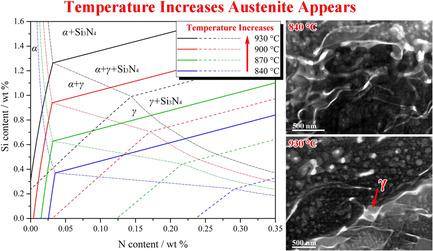当前位置:
X-MOL 学术
›
Steel Res. Int.
›
论文详情
Our official English website, www.x-mol.net, welcomes your
feedback! (Note: you will need to create a separate account there.)
Why Does Nitriding of Grain‐Oriented Silicon Steel Become Slower at Higher Temperature?
Steel Research International ( IF 1.9 ) Pub Date : 2021-01-05 , DOI: 10.1002/srin.202000545 Qinyi Guo 1 , Xianhao Li 2 , Peng Gong 3 , John Nutter 3 , William Mark Rainforth 3 , Haiwen Luo 1
Steel Research International ( IF 1.9 ) Pub Date : 2021-01-05 , DOI: 10.1002/srin.202000545 Qinyi Guo 1 , Xianhao Li 2 , Peng Gong 3 , John Nutter 3 , William Mark Rainforth 3 , Haiwen Luo 1
Affiliation

|
The nitriding process plays an essential role in the production of grain‐oriented silicon steel (GOSS) via the acquired‐inhibitor process. It is surprising at first glance to find that the increase of temperature from 840 to 930 °C retards the nitriding of GOSS rather than accelerating it. By both extensive microstructural characterization and thermodynamic calculations, this is attributed to the formation of austenite at high temperature in the oxidization layer, in which N atoms diffuse at a much lower rate than in ferrite. It is concluded that there exists an upper‐limit temperature for the efficient nitriding of GOSS, which is determined by both the preceding decarburization process and the nitriding atmosphere.
中文翻译:

晶粒取向硅钢的氮化为什么会在高温下变慢?
渗氮工艺在通过获得性抑制剂工艺生产取向硅钢(GOSS)中起着至关重要的作用。乍一看,发现温度从840°C升高到930°C会阻碍GOSS的氮化而不是使其加速,这是令人惊讶的。通过广泛的微观结构表征和热力学计算,这归因于高温下在氧化层中形成的奥氏体,其中N原子的扩散速率远低于铁素体中的扩散速率。结论是,GOSS的有效渗氮存在上限温度,该温度由先前的脱碳过程和渗氮气氛共同决定。
更新日期:2021-01-05
中文翻译:

晶粒取向硅钢的氮化为什么会在高温下变慢?
渗氮工艺在通过获得性抑制剂工艺生产取向硅钢(GOSS)中起着至关重要的作用。乍一看,发现温度从840°C升高到930°C会阻碍GOSS的氮化而不是使其加速,这是令人惊讶的。通过广泛的微观结构表征和热力学计算,这归因于高温下在氧化层中形成的奥氏体,其中N原子的扩散速率远低于铁素体中的扩散速率。结论是,GOSS的有效渗氮存在上限温度,该温度由先前的脱碳过程和渗氮气氛共同决定。











































 京公网安备 11010802027423号
京公网安备 11010802027423号